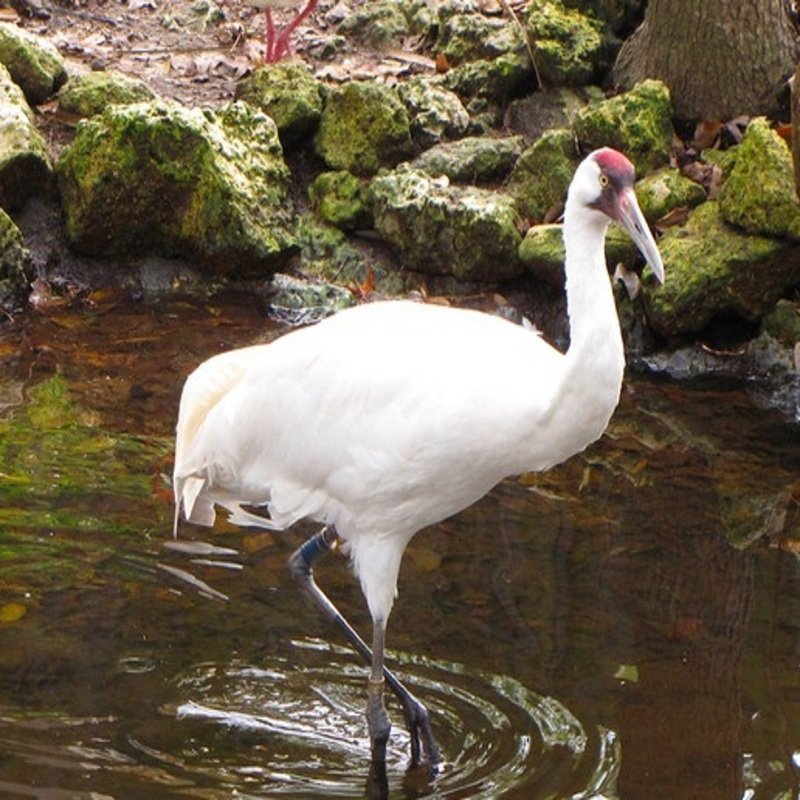Grus americana is North America’s tallest bird commonly known as the Whooping crane in the family of Gruidae. It’s a rare bird. These birds survive 22–24 years in the wild. Unrestricted hunting and habitat loss decreased the population to only 21 wild and two captive whooping cranes by 1941. Around 800 migratory birds, three reintroduced flocks, and captive cranes survive.
Quick Overview: Grus Americana – Whooping Crane
Body size: Around 52 in (132 cm) and a weight of 5804 g (204.8 oz)
Main colors: Gray-rose, Black, White, Brown, Red
Range: Central United States
Migratory Bird: Yes
Best time of the year to see in the U.S.: January, February, December
Conservation Status: Endangered
Whooping crane Description
Mostly white. They have grayish-rose toes and black primary wing feathers. No armor in the crown, lores, or malar regions. The exposed skin is coated with short, thick black bristles. Reddish at the base, gray or olive in color. The male whooping crane weighs more. Males 7.3 kg, females 6.4 kg. Chantilly or brown on top, dull gray or brown underneath. White plumage blotched with cinnamon or brown feathers. The crown’s bare skin has feathers.

Size
These birds have a length of 52 in (132 cm) and a weight of 5804 g (204.8 oz). Their wings could range 87 in (221 cm).
Feeding
They devour both land and water vegetation and animals. These are winter foods: acorns, grasshoppers, mice, and snakes. Low protein and fat winter meals include blue crabs and wolfberries. During their migration across the Midwest and Saskatchewan, whooping cranes consume plant tubers and abandoned grains. It eats minnows, insects, frogs, berries, clams, and snails.
Habitat
It loves open areas near water and plants to breed. The wide space is crucial for predator detection. That’s a good question. Bulrush (Scirpus validus) marshes replace bogs. There are frequently willow, sedge, mudflats, and cattail marshes (Typha latifolia). These areas not only safeguard predators but also provide food. During migration, whooping cranes seek a similar habitat. On seeks salty bays and coastal wetlands in winter. pH 7.6 to 8.3 favored pH americana.
Behavior
Whooping cranes are diurnal and nocturnal. Historically, Grus americana migrated, but only two of the three wild populations now do. Whooping cranes usually live in couples or small families. They may move around by walking or flying. Depending on the flight style, whooping cranes can flap, soar, or glide. Long migratory flights need soaring and gliding. Whooping cranes walk with a bobbed head. Young chicks frequently swim. The whooping crane uses diversion and threat displays to deter predators.
Grus Americana Scientific Classification
- Kingdom: Animalia
- Phylum: Chordata
- Subphylum: Chelicerata
- Class: Aves
- Order: Gruiformes
- Family: Gruidae
- Genus: Grus
- Species: Grus americana
Best time of the year to see
The best time to see these birds in the United States is during the winter season (December to February).
Distribution of the Whooping crane in the USA
Grus americana is a Nearctic migratory bird species. The historical breeding range included the whole central United States and Canada, as well as areas of north-central Mexico. Today’s wild populations are rare. One population breeds in Canada’s Wood Buffalo National Park and winters in Texas‘ Aransas National Wildlife Refuge. A second, smaller population spends the summer in Idaho, Wyoming, and Montana then migrates to the Rio Grande Valley of New Mexico for the winter. A third non-migratory introduced population lives in Kissimmee Prairie, Florida. They migrate across North Dakota, South Dakota, Kansas, Nebraska, Oklahoma, Montana, and Saskatchewan.
